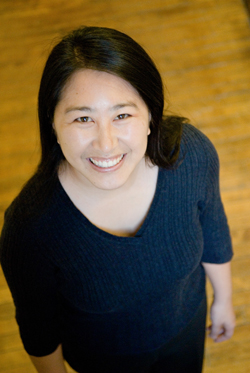Loaded Conversations
When it comes to racial sensitivity, Linda Lin believes that one reason why so few people and institutions successfully "walk the talk" is that even talking the talk is no easy task.
Lin, minority postdoctoral Fellow in the Department of International and Transcultural Studies, has made conversations about race the focus of her study and found that even those with the best of intentions get into conflict situations when discussing racial issues.
As a doctoral student at Stanford, Lin focused her research on a group of dedicated individuals working in a school reform organization to close the achievement gap. In spite of their good intentions, they found that trying to talk about race resulted in conflict. When efforts were made to deal with conflict in public discussions on racial issues, many felt that the situation was made worse.
Eventually, "race conversations went underground," Lin said. Private conversations about race centered on themes of dismay about being considered racist, about conversations being shut down when others became offended and about the dearth of conversations between white people and people of color. Through their efforts, the organization's members were contributing to the very problem they were trying to address.
"It turns out that closing the achievement gap means different things to different people," Lin explains. "We are in a culture that promises equality and systematically produces inequality, and that tension is reflected in our conversations about race. It is not news that these conversations are hard to have."
Lin became interested in race conversations as a teacher, when she helped to organize workshops on multicultural education for other teachers. "They didn't seem to work," she said. "Either the conversation remained superficial and people went home feeling virtuous, or people got so upset that we wondered if they were completely turned off to diversity issues."
Lin does not prescribe a set of guidelines for talking about race. Instead, she explains how conflicts arise and shows why each of them must be worked out on its own terms. "Guidelines are often too vague to be of much help," she says.
Another study Lin did, on community organizing in schools, also revealed the depth of racial tensions. A community worker mentoring a multiracial group of interns worried that her treatment of African American interns could be considered racist. In another case, an Asian American teacher being mentored by a white teacher asked Lin, "How do I tell my mentor that I'm uncomfortable with the ways she teaches about The Joy Luck Club?" Lin discovered that in many instances race "feels too dangerous" to talk about, and that we struggle to deal with the ambiguities of race in our everyday lives.
While at TC, Lin is continuing her research with teachers, social workers, counselors - anyone who does work involving diversity. In talking to people who deal with race and class in their work, Lin hopes to draw on their experiences to see how conflicts that surface are dealt with: "I want to talk with people doing this work on the ground. What are they seeing? What are the common challenges and how are people responding?"
Ultimately, Lin believes people have to decide if it is safe to say something about race and what the chances are that their saying something will result in the outcome they are looking for. "We all have to struggle to figure out how race matters and when," Lin says. "It is not a clean starting point and end point; life is more complicated than a clear problem and resolution, and I am interested in how we handle it in our everyday lives."
Published Friday, Dec. 8, 2006
